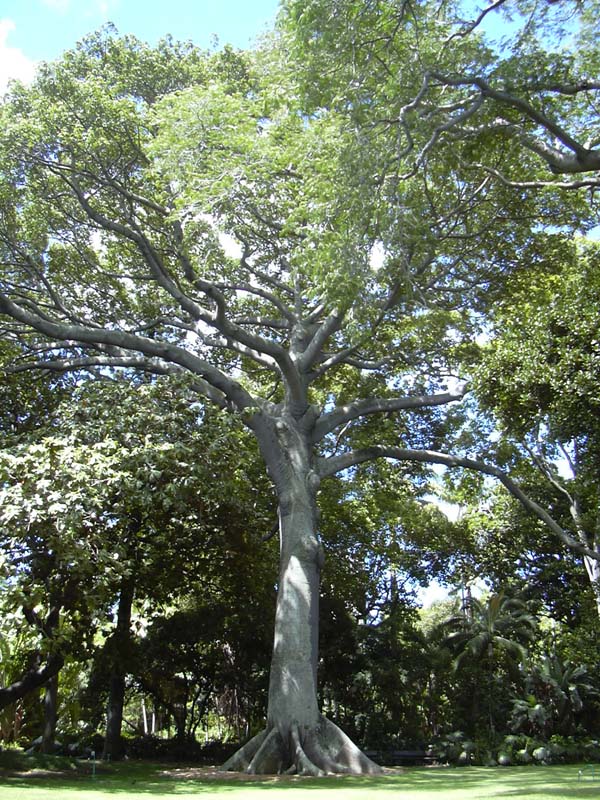- Kapok
:"For the children's book, see
The Great Kapok Tree ".taxobox
name = Kapok
image_caption = Kapok planted inHonolulu ,Hawaii
regnum =Plantae
unranked_divisio =Angiosperms
unranked_classis =Eudicots
unranked_ordo =Rosids
ordo =Malvales
familia =Malvaceae
genus = "Ceiba "
species = "C. pentandra"
binomial = "Ceiba pentandra"
binomial_authority = (L.) Gaertn.|Kapok ("Ceiba pentandra") is a tropical
tree of the order "Malvales " and the family "Malvaceae " (previously separated in the family "Bombacaceae "), native toMexico ,Central America and theCaribbean , northernSouth America , and (as the variety "C. pentandra" var. "guineensis") to tropical westAfrica . The word is also used for thefibre obtained from itsseed pod s. The tree is also known as the Java cotton, Java kapok, orceiba . It is a sacred symbol inMaya mythology .The tree grows to 60-70 m (200-230 ft) tall and has a very substantial trunk up to 3 m (10 ft) in diameter with buttresses. The trunk and many of the larger branches are densely crowded with very large, robust simple thorns. The leaves are compound of 5 to 9 leaflets, each up to 20 cm (8 in) and palm like. Adult trees produce several hundred 15 cm (6 in) seed pods. The pods contain seeds surrounded by a fluffy, yellowish fiber that is a mix of
lignin andcellulose .Uses
The fibre is light, very buoyant, resilient, highly flammable and resistant to
water . The process of harvesting and separating the fibre is labour-intensive and manual. It cannot be spun but is used as an alternative to down as filling inmattress es,pillow s,upholstery ,teddy bear s,zafu s and for insulation. It was previously much used in life jackets and similar devices. The fibre has been largely replaced by man-made materials. The seeds produce anoil used locally insoap and that can be used asfertilizer .In
Southeast Asia n countries kapok has larger seed pods and the fibre which is highly flammable is used as a fuel infire piston s, inThailand called taban fai [http://www.thailex.info/THAILEX/THAILEXENG/LEXICON/t.htm#taban%20fai%20(ตะบันไฟ) ตะบันไฟ] .The commercial tree is most heavily cultivated in
Asia , notably in Java (hence its nicknames),Philippines , andMalaysia , but also in South America.A similar fibre is found in the Indian "Bombax ceiba" (also known as "Bombax malabaricum" or "silk-cotton tree"). It is termed Indian kapok and is darker in colour and less buoyant than the true variety.Another species, the Kapok Bush "
Aerva javanica ", produces a material that is used for stuffing pillows.Cite book|title=Wanggalili; Yinjibarndi and Ngarluma Plants|author=Burndud|publisher= Juluwarlu Aboriginal Corporation |date=1990|page=19]This tree is the official national tree of
Puerto Rico .Ethnomedical uses
"Ceiba pentandra" bark
decoction has been used as adiuretic ,aphrodisiac , and to treat headache, as well astype II diabetes ."Ceiba pentandra" is used as an additive to some versions of the hallucinogenic drink
Ayahuasca . [ [http://www.serendipity.li/dmt/hoasca.html#tbl1 Ayahuasca Analogues] ]References
* [http://www.ars-grin.gov/cgi-bin/npgs/html/taxon.pl?9703 Germplasm Resources Information Network: "Ceiba pentandra"]
* [http://www.thailex.info/THAILEX/THAILEXENG/LEXICON/kapok.htm The larger seed pods of SEA kapok and its use as a fuel in fire pistons]
* [http://www.westafricanplants.senckenberg.de/root/index.php?page_id=14&id=299 Ceiba pentandra] in Brunken, U., Schmidt, M., Dressler, S., Janssen, T., Thombiano, A. & Zizka, G. 2008. West African plants - A Photo Guide. Forschungsinstitut Senckenberg, Frankfurt/Main.Gallery
Gallery of "Ceiba pentandra" & Birds/a Bat on it
Wikimedia Foundation. 2010.
